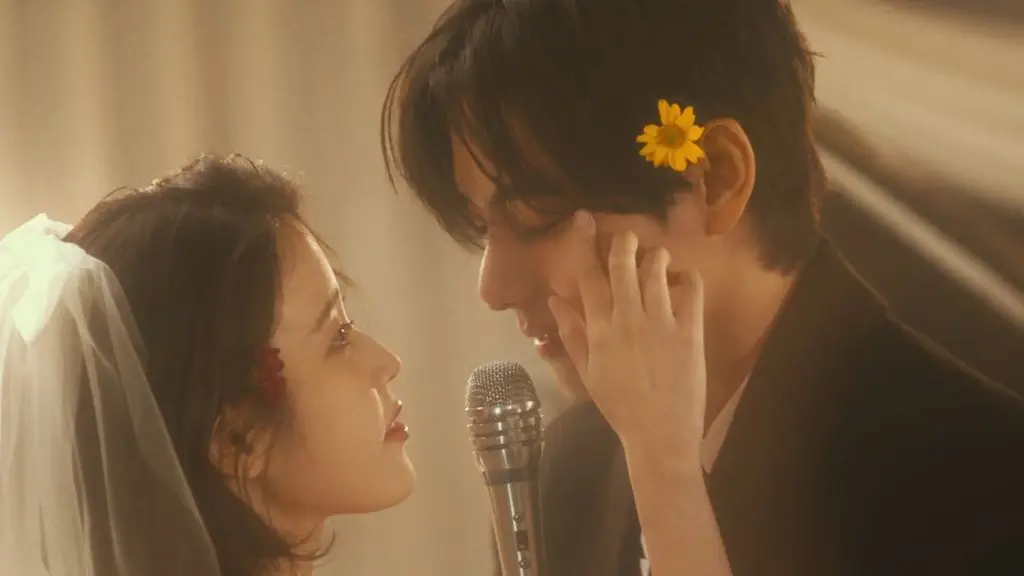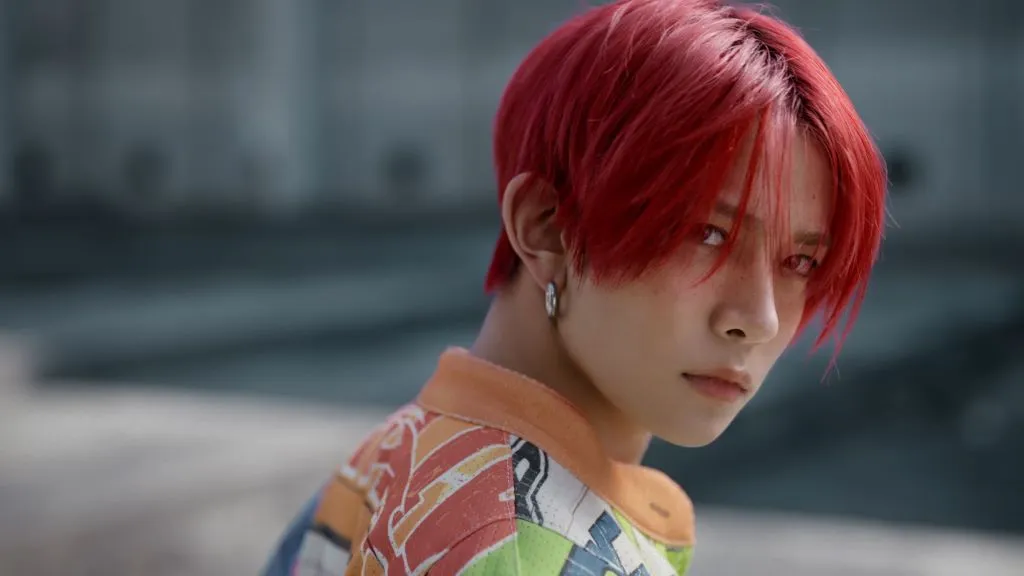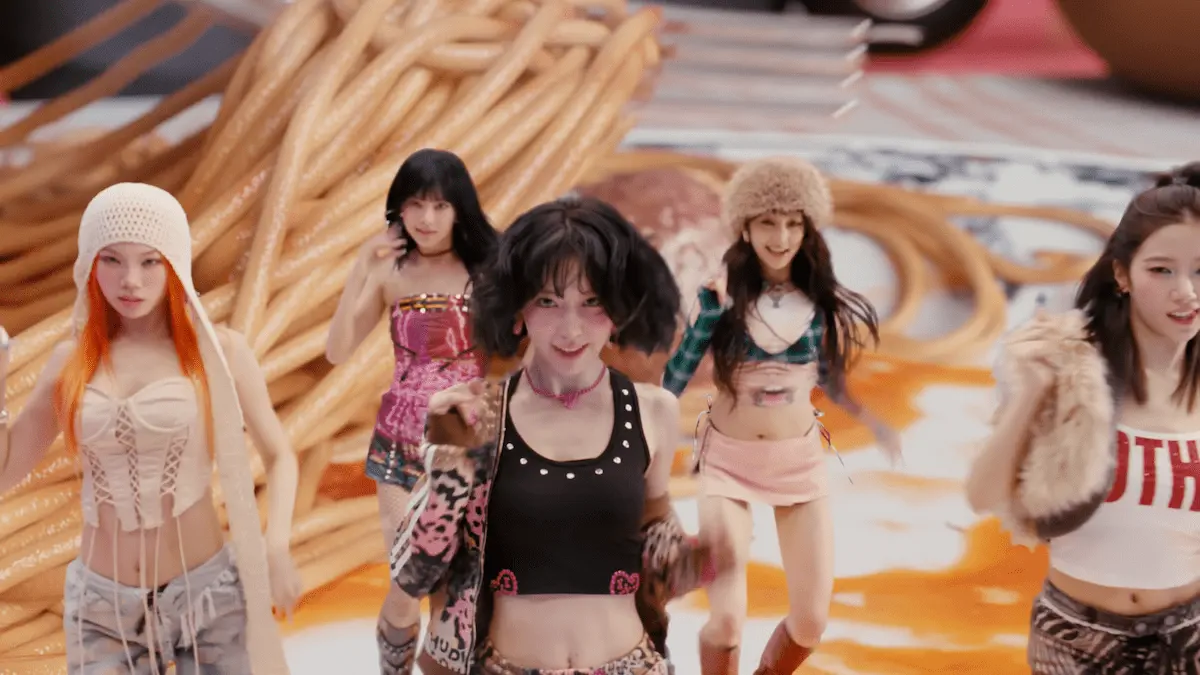[IU 'Love wins all'] - A Deep Dive into a Rebellion Disguised as a Ballad
Let's get one thing straight: IU's "Love wins all" is not your typical K-pop ballad. It's a five-minute cinematic gut-punch that uses a dystopian nightmare to ask a very real question: What does it mean to love in a world that wants you erased? Directed by Uhm Tae-hwa, the mastermind behind 'Concrete Utopia,' and co-starring V of BTS, this music video is less of a promotional clip and more of a standalone piece of art. Forget everything you think you know about love songs. We're about to unpack how IU crafted a narrative with such significant social implications.

Source: Official IU YouTube (© EDAM Entertainment)
Table of Contents (Find Your Story)
Quick Summary: The Vibe Check
In a desolate, post-apocalyptic world, IU and V are fugitives on the run from a mysterious floating cube that annihilates everything in its path. They find refuge in a derelict department store and discover a camcorder that shows them an alternate reality where they are happy, whole, and free from persecution. They choose to live out their final moments in this beautiful illusion, creating their own joy before being found and ultimately erased by the cube.
Credits
The Story You See on Screen
The music video opens with a sense of panic. IU and V, battered and desperate, flee through a desolate forest, pursued by a menacing, silent cube. They find sanctuary in a ruined shopping mall, a ghost of a forgotten civilization. V, who appears to be blind in one eye, and IU, who is non-verbal, communicate through weary gestures, their bond palpable in the silence. Their discovery of an old camcorder at (1:23) becomes the story's turning point.
Looking through the lens, the world transforms. The dusty ruins become a lavish restaurant, and their tattered clothes are replaced by pristine outfits. The camcorder doesn't just record; it reveals a world as it *should* be—a world where they are not hunted but celebrated. They indulge in this beautiful fiction, sharing a meal, taking photos in a vintage photobooth (2:52), and finding a wedding dress and tuxedo. In a profoundly moving sequence, they create their own wedding ceremony amidst the rubble, a defiant act of normalcy in an insane world.
However, reality inevitably intrudes. The cube locates them, its ominous presence filling the mall at (4:30). Instead of running, they face it together, holding each other close. As the cube's energy envelops them, they don't scream or struggle; they float serenely, smiling. The video ends not with their bodies, but with their clothes—the wedding dress and tuxedo—falling to the ground in a silent heap at (4:58). Their physical forms are gone, but the symbol of their love remains.
Lyrics & meaning
Lyrical Story & Narrative
IU's self-penned lyrics tell a story of two people choosing each other against a hostile world. The song opens with the staggeringly intimate plea: "Dearest, darling, my universe / Will you take me with you?" This isn't just romantic hyperbole; in their apocalyptic reality, this person is literally her entire world. The lyrics then immediately establish the conflict, identifying a clear antagonist in the world itself. The core message revolves around a desperate but determined escape, not just from a physical threat, but from a world that rejects them.
The narrative is built on the recurring plea to run away together, as heard in the chorus: *"세상에게서 도망쳐 Run on / 나와 저 끝까지 가줘 My lover"* (Escape from the world, run on / Go with me to the very end, my lover). [cite: 1] This isn't about a naive hope for a happy ending, but about the profound choice to face the journey's end together. It’s about finding courage not for a grand victory, but for the next small step, hand in hand. This theme of defiant companionship is the song's emotional anchor, a promise to remain together no matter the destination.
The Intent Behind the Hook & Cultural Nuance
While the lyrics don't explicitly say it, the song's ultimate message is a powerful redefinition of what a "sad ending" means. In the story's logic, a tragic end would be to be defeated alone, broken, and erased by the world's hatred. By choosing to face their final moments together, after defiantly creating their own joy, they achieve a form of victory. The "win" in "Love wins all" isn't survival; it's the self-determination of choosing love until the very end. The title itself becomes their final, triumphant statement.
This concept taps into the Korean cultural emotion of **'Han (한)'**—a deep-seated feeling of sorrow and injustice—but radically subverts it. Traditional Han in art often involves passive suffering. IU transforms it into active resistance; their love becomes a defiant act against the forces causing their pain. Furthermore, IU’s choice of the formal, poetic Korean term for 'you', **'그대 (geudae)'**, elevates their relationship beyond simple romance. It's a word that bestows sanctity and reverence, framing their bond as something sacred being affirmed in the face of oblivion. This is why the song feels so revolutionary—it uses the language of love as a tool of rebellion.
Beneath the Surface: A Multi-Layered Analysis
1. Fashion Deconstruction: The Symbolism of Rags and Riches
While "Love wins all" isn't a fashion-centric video, its costume design is deeply symbolic. The characters begin in dirt-stained, tattered clothes—visual signifiers of their status as outcasts. These are not specific brands but rather anti-fashion; their purpose is to show the characters stripped of all societal markers except for their struggle. This makes the transformation all the more powerful. The moment they discover the pristine wedding dress and classic tuxedo at (3:25) is a pivotal narrative beat.
These outfits represent the life they were denied—a life of celebration, normalcy, and societal acceptance. The crisp white of the dress and the sharp black of the tux are in stark contrast to the grimy, desaturated world around them. It's a visual argument that their love is pure and dignified, even if the world sees them as refuse. The final shot, where only the clothes remain (4:58), is devastatingly effective. Their bodies are gone, but the symbols of their love and their self-made ceremony persist, a silent testimony to their rebellion.
2. The Sound: A Producer's Perspective on Building Tension
The song's production, helmed by IU's longtime collaborator **Seo Dong-hwan**, is a masterclass in minimalism and emotional escalation[cite: 2]. The track begins with only a sparse, melancholic piano, creating an immediate sense of intimacy and vulnerability. Notice the lack of percussion for the first half of the song. This is a deliberate choice. Drums would create a sense of urgency and panic, but the song's message is one of calm defiance.
The arrangement builds tension with surgical precision. Strings are subtly introduced in the first pre-chorus at (1:00), adding a layer of cinematic grandeur without overwhelming IU's delicate vocals. The true emotional crescendo begins in the bridge at (3:10). As IU's voice rises with emotion, the orchestration swells, and for the first time, a soft percussive element enters, mirroring a heart beginning to race as the inevitable approaches. The final chorus unleashes the full orchestral power, perfectly mirroring the narrative arc: from a whispered secret in the ruins to a triumphant shout in the face of oblivion.
3. Cinematic Language: Reading Between the Frames
Director **Uhm Tae-hwa** brings a feature film sensibility to every shot[cite: 2]. The use of a **shaky, handheld camera** in the opening sequence (0:25) immediately immerses us in the characters' panic, lending a raw, documentary-like authenticity to their plight. This contrasts sharply with the smooth, stable shots used for the camcorder scenes, visually separating the chaotic reality from the idealized memory.
The **color grading** is a powerful storytelling tool. The "real" world is rendered in a cold, desaturated palette of blues and grays. In stark contrast, the world seen through the camcorder at (1:55) is saturated with warm, golden tones. This visual shift represents the "filter of love," an interpretation confirmed by the director. This isn't just a stylistic choice; it's the video's central metaphor made visible.
Uhm Tae-hwa also employs classic cinematic grammar to heighten emotion. The **montage sequence (2:50 - 3:20)**, which intercuts scenes of them eating, laughing in the photobooth, and singing, rapidly builds an emotional connection for the audience. We see the life they could have had, making the impending conclusion all the more tragic. Finally, the use of **slow-motion** as they face the cube and disintegrate (4:55) turns their final moments into a serene, almost balletic tableau, cementing the idea that they are choosing how they meet their end.
4. Performance: The Power of Silent Storytelling
With no complex choreography, the focus shifts entirely to the raw acting performances of IU and V. This is where their chemistry and individual skills truly shine. IU's portrayal of a non-verbal character is incredibly nuanced. She conveys a universe of fear, love, and resilience through her eyes and subtle gestures alone, particularly in the moment she silently pleads with V before entering the mall at (0:55).
V, building on his acting experience, delivers a performance of startling emotional depth. He masterfully communicates his character's protective instincts and profound sadness. The way his single seeing eye softens when he looks at IU through the camcorder lens speaks volumes. The scene in the photobooth (2:52) is a perfect example of their synergy; their playful interactions feel completely natural, a testament to their real-life friendship being channeled into their roles. This isn't just "idol acting"; it's a powerful and moving piece of collaborative storytelling.
Fan Takeaways
For fans, "Love wins all" felt like a seismic event. It wasn't just a pre-release single; it was a statement. This was IU, one of K-pop's most respected lyricists, using her platform to tell a story with immense depth. The collaboration with V brought together two of the industry's biggest fandoms, creating a massive global conversation that went far beyond typical comeback hype.
What resonated most deeply was the video's allegorical nature. The cube, representing "various forms of discrimination and oppression" according to director Uhm Tae-hwa, allowed fans from marginalized communities to see their own struggles reflected in the story. It was embraced as a powerful anthem about forbidden love, finding wholeness in each other, and standing defiant against a world that doesn't understand.
Ultimately, this MV gave fans a piece of art to dissect and discuss for months. It trusted our intelligence, leaving room for interpretation while providing a clear emotional core. It's the kind of content that turns a listener into a lifelong admirer because it doesn't just entertain—it makes you feel, and it makes you think. It's a reminder that a love song can be one of the most powerful forms of protest.
You Might Also Like
- [Album Review] IU's 'The Winning': A Track-by-Track Breakdown
- [Deep Dive] The Evolution of K-Pop Ballads: From Grief to Resistance
- [MV Explained] AKMU's 'Nakka': A Story of Trust in Freefall
Frequently Asked Questions (Q&A)
What does the cube in IU's 'Love wins all' MV symbolize?
According to the director, Uhm Tae-hwa, the cube symbolizes "the various forms of discrimination and oppression present in our daily lives." It's intentionally left ambiguous to represent any force, societal or otherwise, that seeks to marginalize or erase individuals, making the story's themes universally relatable.
What is the meaning behind the camcorder in the music video?
The camcorder represents the "filter of love." It shows the world not as it is, but as it could be, filled with warmth, happiness, and beauty. Director Uhm Tae-hwa explained it as a device that allows the characters to see beyond their harsh reality to a more idealized version of the world and themselves, reflecting the power of a loving perspective.
What is the core message of "Love wins all"?
The core message is that love's "win" isn't necessarily about overcoming all obstacles or achieving a happy ending. Instead, it's about the defiant choice to love and find joy in the face of overwhelming adversity. The victory lies in maintaining one's humanity and choosing companionship until the very end, thereby defining one's own ending rather than letting the oppressive world define it for you.




Comments